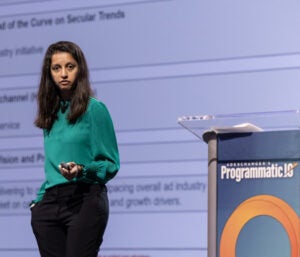As a builder of mini walled gardens for publishers, Swedish self-serve platform provider DanAds has a front-row seat to the challenges of monetization.
Ad tech take rates and macroeconomic pressures are squeezing publishers.
But for DanAds, which helps publishers seize more control over the advertising supply chain and cuts out middlemen, business has been good.
DanAds, whose clients include The Washington Post, Bloomberg and McClatchy, is in growth mode, and its COVID-19-delayed US expansion is in full swing, said CEO Istvan Beres. It also has its sights set on profitability by the end of the year.
But the volatile market has DanAds rethinking its IPO.
There’s no need to rush toward an IPO, though, Beres said. “We’ll see what the right decision is when the market has gotten a little bit more normal.”
Beres and his cofounder, Peo Persson, spoke with AdExchanger.
AdExchanger: Toward the end of 2021, DanAds said it was considering an IPO within the next 12 to 18 months. Is an IPO still in the works for this year?
ISTVAN BERES: It’s on our road map, but we haven’t decided if it will be this year or later. Luckily, just before the market shift, we had [an equity financing round] that sold out. And the European Investment Bank gave us a big credit facility. So, we have the money to execute our plan. But we’ll revisit the IPO plan after this summer.
What are some changes you’d need to see in the market to feel more positive about an IPO?
BERES: We want to see normal valuations. Many tech companies went public, got a high valuation and, half a year later, 90% of the valuation is gone.
Those crazy valuations only last for six months and you just disappoint a lot of people, including your employees, because everybody believes they’re billionaires.
PEO PERSSON: We don’t want to look at the short term and say, “We’re going to have a 50-times valuation, then sell off 50% of our stock.” That’s not the Swedish way to do it.
How has your path to profitability changed?
BERES: The plan was to be profitable at the end of 2024, so we shortened it. We didn’t drop any plans for how fast we will grow, but we are looking more at how we spend our money. We’ll perhaps lower our R&D investment for 2023.
What’s your current headcount, and what are your hiring priorities?
BERES: We’re about 230 people. The majority is in Europe, and tech is the biggest division. We moved our CTO Johan Liljelund to the US last year to start building up the team. By the end of February, we had eight people in the US.
PERSSON: The US is basically the commercial office. We’re looking to be 15 to 20 people at the end of this year on the commercial side in New York. After that, most likely we will try to grow on the West Coast because we have important clients there.
Have you run into any issues managing the company through a global expansion?
BERES: Most of our development team was in Ukraine. We checked in daily to see if everybody was OK. Workwise, everybody found new ways of doing things very quickly.
In the beginning, if there was no power in their district, but another district had electricity, they would go there and work from a friend’s home. We were in shock at how they adapted and how they delivered on a daily basis. Now, many of those team members work in our hubs in Portugal, Poland, Romania, Hungary and some even ended up in Canada.
What’s the biggest monetization challenge facing publishers today?
PERSSON: Because of reduced publisher headcounts, stakeholders now need to have more control over monetization. We saw that shift around Q3 last year. Publishers started talking about going from quantity to quality and how they can have a tighter grip on the supply chain, rather than handing their inventory to open programmatic.
Is the shift to first-party data giving publishers more control over monetization?
PERSSON: Publishers use a lot of technology. They are connected to SSPs and DSPs, they do their own direct selling and they have platforms to optimize their content and subscription models.
None of them are really talking, and if they don’t start, it’s going to take even longer to get to that end goal.
Do you see self-serve as related to supply-path optimization?
PERSSON: In a sense, but self-serve is for direct business. We can have programmatic interfaces with bid requests that connect to publisher inventory directly. Most publishers don’t want to set up self-service for the programmatic business. They want to take money from the programmatic side and put it into the self-service side.
Publishers are asking for APIs that go from the self-serve platform directly to agency planning platforms. Agencies can hook up to the publisher’s first-party data, see what audiences are available and execute orders.
This setup removes DSPs and SSPs – and their take rates – from the transaction. And it’s good for advertisers that can’t cover minimum spending commitments imposed by DSPs like The Trade Desk.
This interview has been edited and condensed.

















